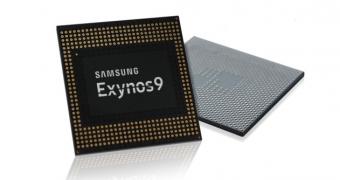Samsung has just announced its Exynos 9 series 8895 chip is currently in mass production. The South Korean company's first chipset manufactured using the 10nm FinFET process technology, the Exynos 9 series processor features enhanced 3D transistor structure.
According to Samsung, the new chipset is 27% faster and consumes 40% less power in comparison with CPUs made with 14nm process technology.
Furthermore, the Exynos 9 series is the world's first chipset to pack a gigabit LTE modem, which is supposed to support no less than five carrier aggregation (5CA). Basically, this means that the chipset can provide blazing fast speeds with throughput at max.1Gbps (Cat.16) downlink and 150Mbps (Cat.13) uplink.
“In addition to being built on the most advanced 10nm FinFET process technology, the new Exynos 9 Series 8895 incorporates Samsung’s cutting-edge technologies including a 2nd generation custom CPU, gigabit LTE modem, and more.
With industry leading technologies like VPU, the Exynos 8895 will drive the innovation of next generation smartphones, VR headsets, and automotive infotainment system,” said Ben Hur, Vice President of System LSI marketing at Samsung Electronics.
Dedicated CPUs for security solutions and image processing included
Samsung's new Exynos 8895 SoC (system-on-chip) accommodates eight cores, comprising four Samsung second-gen custom designed CPU cores for better performance and power efficiency in addition to four Cortex A53 cores.
Aside from the octa-core processor, the chipset packs an ARM Mali-G71 graphics processing unit that's supposed to offer the “next level 3D graphic performance that minimizes latency for 4K UHD VR gaming experience.”
Samsung also revealed that its Exynos 8895 chipset features a dedicated processing unit for improved security solutions, which is required for mobile payments that use various authentication methods like iris or fingerprint recognition
Also, the Exynos 9 Series comes with an embedded Vision Processing Unit (VPU) that can recognize and analyze items or movements for better video tracking, panoramic image processing, as well as machine vision technology.

 14 DAY TRIAL //
14 DAY TRIAL //